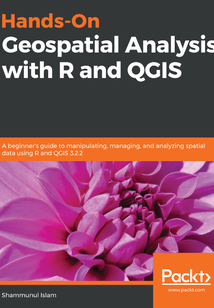舉報(bào) 

會(huì)員
Hands-On Geospatial Analysis with R and QGIS
Managingspatialdatahasalwaysbeenchallengingandit'sgettingmorecomplexasthesizeofdataincreases.Spatialdataisactuallybigdataandyouneeddifferenttoolsandtechniquestoworkyourwayaroundtomodelandcreatedifferentworkflows.RandQGIShavepowerfulfeaturesthatcanmakethisjobeasier.ThisbookisyourcompanionforapplyingmachinelearningalgorithmsonGISandremotesensingdata.You’llstartbygaininganunderstandingofthenatureofspatialdataandinstallingRandQGIS.Then,you’lllearnhowtousedifferentRpackagestoimport,export,andvisualizedata,beforedoingthesameinQGIS.Screenshotsareincludedtoeaseyourunderstanding.Movingon,you’lllearnaboutdifferentaspectsofmanagingandanalyzingspatialdata,beforedivingintoadvancedtopics.You’llcreatepowerfuldatavisualizationsusingggplot2,ggmap,raster,andotherpackagesofR.You’lllearnhowtouseQGIS3.2.2tovisualizeandmanage(create,edit,andformat)spatialdata.DifferenttypesofspatialanalysisarealsocoveredusingR.Finally,you’llworkwithlandslidedatafromBangladeshtocreatealandslidesusceptibilitymapusingdifferentmachinelearningalgorithms.Byreadingthisbook,you’lltransitionfrombeingabeginnertoanintermediateuserofGISandremotesensingdatainnotime.
目錄(188章)
倒序
- coverpage
- Title Page
- Packt Upsell
- Why subscribe?
- Packt.com
- Contributors
- About the author
- About the reviewers
- Packt is searching for authors like you
- Preface
- Who this book is for
- What this book covers
- To get the most out of this book
- Download the example code files
- Download the color images
- Conventions used
- Get in touch
- Reviews
- Setting Up R and QGIS Environments for Geospatial Tasks
- Installing R
- Basic data types and data structures in R
- Basic data types in R
- Variable
- Data structures in R
- Vectors
- Basic operations with vector
- Matrix
- Array
- Data frames
- Lists
- Factor
- Looping functions and apply family in R
- Looping in R
- Functions in R
- Apply family – lapply sapply apply tapply
- apply
- lapply
- sapply
- tapply
- Plotting in R
- Installing QGIS
- Getting to know the QGIS environment
- Summary
- Questions
- Further reading
- Fundamentals of GIS Using R and QGIS
- GIS in R
- Data types in GIS
- Vector data
- Raster data
- Plotting point data
- Importing point data from Excel
- Plotting lines and polygons data in R
- Adding point data on polygon data
- Changing projection system
- Plotting quantitative and qualitative data on a map
- Using tmap for easier plotting
- Vector data in QGIS
- Adding Excel data in QGIS using joins
- Adding CSV layers in QGIS
- Showing multiple labels using text chart diagrams
- Adding a background map
- Summary
- Questions
- Further reading
- Creating Geospatial Data
- Getting data from the web
- Downloading data from Natural Earth
- Downloading data from DIVA-GIS
- Downloading data from EarthExplorer
- Creating vector data
- Creating point data
- Creating polygon data
- Adding features to vector data
- Digitizing a map
- Working with databases
- Creating a SpatiaLite database
- Adding a shapefile to a database
- Summary
- Questions
- Further reading
- Working with Geospatial Data
- Working with vector data in R
- Combining shapefiles in R
- Clipping in R
- Difference in R
- Area calculation in R
- Working with vector data in QGIS
- Combining shapefiles
- Converting vector data types
- Polygons into lines
- Lines into polygons
- Clipping
- Difference
- Buffer
- Intersection
- Statistical summary of vector layers
- Using field calculators for advanced field calculations
- Summary
- Remote Sensing Using R and QGIS
- Basics of remote sensing
- Basic terminologies
- Remote sensing image characteristics
- Atmospheric correction
- Working with raster data in R
- Reading raster data
- Stacking raster data
- Changing the projection system of a raster file
- False color composite
- Slope aspect and hillshade
- Slope
- Aspect
- Hillshade
- Normalized Difference Vegetation Index (NDVI)
- Classifying the NDVI
- Working with raster data in QGIS
- False color composite
- Raster mosaic
- Clip raster by mask layer
- Projection system
- Changing projection systems
- Sampling raster data using points
- Reclassifying rasters
- Slope aspect and hillshade in QGIS
- Slope
- Summary
- Questions
- Point Pattern Analysis
- Introduction to point pattern analysis
- The ppp object
- Creating a ppp object from a CSV file
- Marked point patterns
- Analysis of point patterns
- Quadrat test
- G-function
- K-function
- L-function
- Spatial segregation for a bivariate marked point pattern
- Summary
- Spatial Analysis
- Testing autocorrelation
- Preparing data
- Moran's I index for autocorrelation
- Modeling autocorrelation
- Spatial autoregression
- Generalized linear model
- Modeling count data using Poisson GLM
- Spatial interpolation
- Nearest-neighbor interpolation
- Inverse distance weighting
- Geostatistics
- Some important concepts
- Variograms
- Kriging
- Checking residuals
- Summary
- GRASS Graphical Modelers and Web Mapping
- GRASS GIS
- Basics of GRASS GIS
- Database
- Location
- Mapset
- Creating a mapset
- Importing vector data in GRASS
- Importing raster data in GRASS
- False color composite in GRASS
- Graphical modeler
- Web mapping
- Web mapping in QGIS
- Summary
- Classification of Remote Sensing Images
- Classification of raster data
- Supervised classification
- Supervised classification in QGIS
- Creating a validation shapefile
- Unsupervised classification
- Summary
- Landslide Susceptibility Mapping
- Landslides in Bangladesh
- Landslide susceptibility modeling
- Data preprocessing
- Model building
- Logistic regression
- CART
- Random forest
- Summary
- Other Books You May Enjoy
- Leave a review - let other readers know what you think 更新時(shí)間:2021-06-10 18:45:04
推薦閱讀
- Microsoft Dynamics CRM Customization Essentials
- 玩轉(zhuǎn)智能機(jī)器人程小奔
- Google Cloud Platform Cookbook
- 數(shù)據(jù)庫(kù)原理與應(yīng)用技術(shù)學(xué)習(xí)指導(dǎo)
- 可編程控制器技術(shù)應(yīng)用(西門子S7系列)
- Embedded Programming with Modern C++ Cookbook
- 網(wǎng)絡(luò)組建與互聯(lián)
- 嵌入式操作系統(tǒng)
- Nginx高性能Web服務(wù)器詳解
- Linux Shell編程從初學(xué)到精通
- Mastering Ansible(Second Edition)
- 筆記本電腦電路分析與故障診斷
- 計(jì)算機(jī)辦公應(yīng)用培訓(xùn)教程
- Practical Network Automation
- 我的IT世界
- 局域網(wǎng)應(yīng)用一點(diǎn)通
- 巧學(xué)活用WPS
- ARM Cortex-M3嵌入式開發(fā)實(shí)例詳解
- Excel數(shù)據(jù)透視表應(yīng)用之道
- 單片開關(guān)電源集成電路應(yīng)用設(shè)計(jì)實(shí)例
- 深度學(xué)習(xí):語(yǔ)音識(shí)別技術(shù)實(shí)踐
- 基于Proteus的AVR單片機(jī)C語(yǔ)言程序設(shè)計(jì)與仿真
- Hands-On Internet of Things with Blynk
- UGNX 5三維造型
- 存儲(chǔ)技術(shù)原理分析
- 三菱FX系列PLC編程及應(yīng)用(第3版)
- Mastering UDK Game Development
- 深入淺出GAN生成對(duì)抗網(wǎng)絡(luò):原理剖析與TensorFlow實(shí)踐
- PostgreSQL 11 Administration Cookbook
- Photoshop CS3中文版圖像處理與平面設(shè)計(jì)精彩百練

